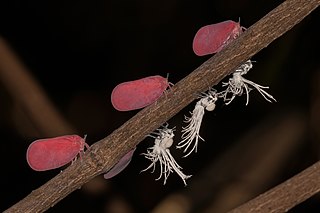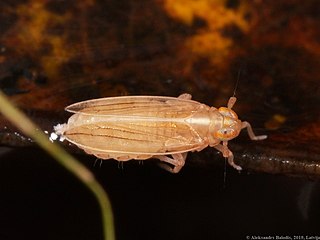
Ricaniidae is a family of planthopper insects, containing over 40 genera and 400 species worldwide. The highest diversity is in tropical Africa and Asia and in Australia, with a few species occurring in the Palearctic. It is one of the smaller families in the planthopper superfamily Fulgoroidea.

Flatidae are a family of fulgoroid planthoppers. They are cosmopolitan in distribution and are distinguished from others in the superfamily by a combination of characters. Like all other planthoppers, they suck phloem sap of plants. Some species are known to communicate with vibrations through the plant stems. Communication may be with mates, or with ants that tend the nymphs, protecting them and gathering honeydew secretions. Adults of some species have brightly coloured forewings which are tougher and known as tegmina unlike the membranous hindwings which are used for flight. Although a few can be identified by their coloration, most species requires dissection and examination under a microscope with access to literature on already described species.

Issidae is a family of planthoppers described by Spinola in 1839, belonging to the order Hemiptera, suborder Auchenorrhyncha superfamily Fulgoroidea.

Issus is a genus of planthoppers belonging to the family Issidae of infraorder Fulgoromorpha of suborder Auchenorrhyncha of order Hemiptera. Like most members of the order Hemiptera they live on phloem sap that they extract with their piercing, sucking mouth parts.

Nogodinidae is a family of planthoppers. They have membranous wings with delicate venation and can be confused with members of other Fulgoroid families such as the Issidae and Tropiduchidae. Some authors treat it as a subfamily of the Issidae. Some of their key features are a frons ("face") that is longer than wide and a reticulate wing venation. They are less than 2 cm long. The antenna arises well below the eye, has the base clubbed and flagellum unsegmented. The lateral ocelli are outside the margins of the face. The face has carinae on the edge. On the hind leg, the second tarsal segment has an apical spine arising from it. The tibia of the hind leg also has spines towards the tip. An important family character is found in the shape of the male genital structure, a style that is longer than broad. Most members of this family are forest species.

Caliscelidae is a family of planthoppers, sap-sucking insects that belong to the order Hemiptera, suborder Auchenorrhyncha and superfamily Fulgoroidea. They are somewhat anomalous and have often been included within the family Issidae. Studies made in 2013 of the phylogeny of the Issidae and other groups using molecular techniques support the treatment of the group as a separate family. Sexual dimorphism can be marked. Some members of the family are called piglet bugs due to the shape of their snout. A particularly aberrant genus described in 2011 from India, Formiscurra, has males that resemble ants.

Formiscurra indicus is a species of planthopper in the family Caliscelidae found in southern India. A related species, Formiscurra atlas occurs in southwestern Ethiopia. Like others of its family they have short wings, suck plant sap and escape by leaping. The species shows great sexual dimorphism. The male of this half centimeter-long insect has an enlarged lobe in front of its head, the frons or metope, giving it an ant-like appearance. Females do not have such an enlarged structure but have a slightly long snout and differ slightly in body shape. The species is found mainly on low vegetation in open scrub and grass habitats.

Conosimus baenai is a species of planthopper native to the Iberian Peninsula in Spain. Its coloration ranges between light yellow and greenish-yellow. Males measure about 4.1–4.4 millimeters in length while females measure about 4.7–5.0 millimeters. The species was named after Manuel Baena, a hemipterologist.
Falcidius is a genus of planthoppers in the family Issidae.

Javesella is a genus of delphacid planthoppers in the family Delphacidae. There are at least 20 described species in Javesella.

Nothodelphax is a genus of delphacid planthoppers in the family Delphacidae. There are more than 20 described species in Nothodelphax.

Fieberiella is a genus of leafhoppers in the family Cicadellidae. There are at least 20 described species in Fieberiella.

Delphacodes is a genus of delphacid planthoppers in the family Delphacidae. There are at least 230 described species in Delphacodes.

Criomorphus is a genus of delphacid planthoppers in the family Delphacidae. There are about 13 described species in Criomorphus.

Kelisia is a genus of delphacid planthoppers in the family Delphacidae. There are more than 50 described species in Kelisia.

Muirodelphax is a genus of delphacid planthoppers in the family Delphacidae. There are about 13 described species in Muirodelphax.

Agalmatium is a genus of planthoppers belonging to the family Issidae, subfamily Issinae.

Formiscurra is a genus of planthopper in the family Caliscelidae with two species Formiscurra indicus of southern India and Formiscurra atlas from southwestern Ethiopia. Like others of its family they have short wings, suck plant sap and escape by leaping. The species shows great sexual dimorphism. The males of this half centimeter-long insect have an enlarged lobe in front of its head, the frons or metope, giving it an ant-like appearance. Females do not have such an enlarged structure but have a slightly long snout and differ slightly in body shape. The species is found mainly on low vegetation in open scrub and grass habitats. It has been suggested, based on the Afro-Indian distribution, that the ancestral species of this and other genera Chirodisca and Rhinogaster, evolved in Eurasia and spread to Africa 5-7 million years ago when the Tethys sea closed and thus their ancestors would have been part of the late Miocene Hipparion fauna.

The Hemisphaeriinae are a subfamily of bugs in the family Issidae, based on the type genus Hemisphaerius. Species in 107 genera have been recorded in most continents, but the greatest diversity appears to be in South-East Asia.
Jassargus is a genus of leafhoppers belonging to the family Cicadellidae. The genus was first described by Zachvatkin in 1934. The species of this genus are found in Europe, Asia, Algeria, Greenland and Canada.

















